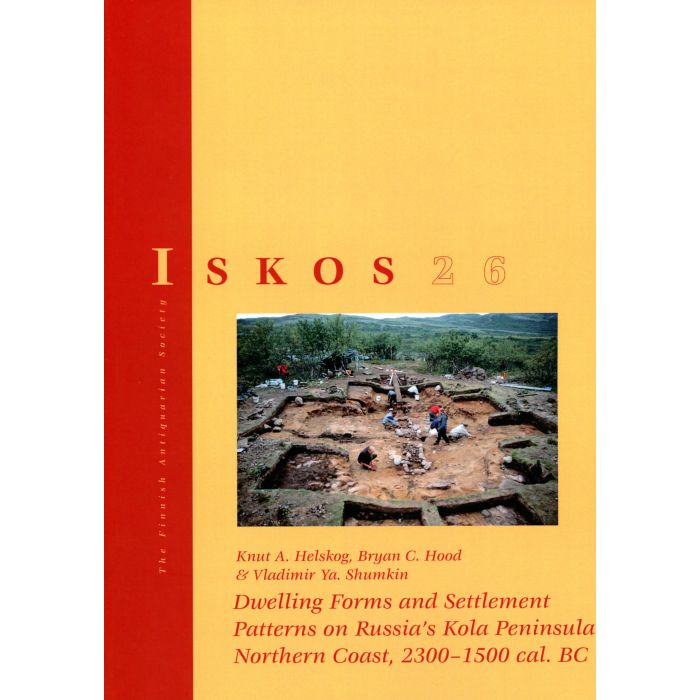We use cookies to make your experience better. To comply with the new e-Privacy directive, we need to ask for your consent to set the cookies. Learn more.
Dwelling Forms and Settlement Patterns on Russia's Kola Peninsula Northern Coast, 2300–1500 cal. BC
€20.00
In stock
SKU
978-952-6655-37-6
Helskog, Knut A. & Hood, Bryan C. & Shumkin, Vladimir Ya.
Dwelling Forms and Settlement Patterns on Russia's Kola Peninsula Northern Coast, 2300–1500 cal. BC
Suomen Muinaismuistoyhdistys
Iskos 26
Tampere 2023, 185 pp.
Dwelling Forms and Settlement Patterns on Russia's Kola Peninsula Northern Coast, 2300–1500 cal. BC
Suomen Muinaismuistoyhdistys
Iskos 26
Tampere 2023, 185 pp.
Prehistoric semisubterranean house structures began to be identified along the coast of northern Norway during the 1930s, and by the 1960s hundreds of them had been registered. Today we know that most of these date to the Late Stone Age (5000-1800 BC) and the Early Metal Age (1800 BC to AD 1), although some are also known from the Mesolithic (Early Stone Age; 9000-5000 BC). During the inter-war years, when Finland had sovereignty over the Petsamo/Petchenga region at the western end of the Kola Peninsula, Finnish archaeologists identified similar houses in that region.
After World War II, Russian archaeologists working on the Kola Peninsula coast did not register pit-houses; the various depressions noted at coastal localities were either regarded as natural or the result of military activities during the war. After the opening-up of Russia to foreign researchers in the early 1990s, and the participation of Russian researchers in Norwegian excavations, collaborative work with Norwegian archaeologists on the Kola Peninsula (Figure 1.1) led to the registration of many house structures' some very similar in form to those known in northern Norway. Since then, the inventory of semisubterranean houses on Kola has greatly expanded, as Russian archaeologists have surveyed new areas and have excavated dwelling features as part of heritage management projects related to oil and gas development.
The first modern excavation of a semisubterranean house on the Kola Peninsula, however, was undertaken by a Norwegian-Russian team at Drozdovka Bay, in 1994, 1998 and 2000. The project was an exercise in cross-cultural collaboration, and it attempted to align the archaeology of the Kola coast with the better-known archaeology of the north Norwegian coast, as it was obvious from the houses and their material culture that the Kola-Norwegian coast constituted a culturally related interaction area.
This book presents the results of this first house-site investigation and attempts to place it in a broader context, relative to other investigations on the Kola Peninsula and those in northern Norway.
After World War II, Russian archaeologists working on the Kola Peninsula coast did not register pit-houses; the various depressions noted at coastal localities were either regarded as natural or the result of military activities during the war. After the opening-up of Russia to foreign researchers in the early 1990s, and the participation of Russian researchers in Norwegian excavations, collaborative work with Norwegian archaeologists on the Kola Peninsula (Figure 1.1) led to the registration of many house structures' some very similar in form to those known in northern Norway. Since then, the inventory of semisubterranean houses on Kola has greatly expanded, as Russian archaeologists have surveyed new areas and have excavated dwelling features as part of heritage management projects related to oil and gas development.
The first modern excavation of a semisubterranean house on the Kola Peninsula, however, was undertaken by a Norwegian-Russian team at Drozdovka Bay, in 1994, 1998 and 2000. The project was an exercise in cross-cultural collaboration, and it attempted to align the archaeology of the Kola coast with the better-known archaeology of the north Norwegian coast, as it was obvious from the houses and their material culture that the Kola-Norwegian coast constituted a culturally related interaction area.
This book presents the results of this first house-site investigation and attempts to place it in a broader context, relative to other investigations on the Kola Peninsula and those in northern Norway.
| Publisher | Finnish Antiquarian Society |
|---|---|
| ISBN | 978-952-6655-37-6 |
| ISSN | 0355-3108 |
| Series | Iskos |
| Published (year) | 2023 |
| Cover | Softcover |
| Type of Binding | Softcover binding |
| Languages | english |
| Disciplines | Archaeology, History |


